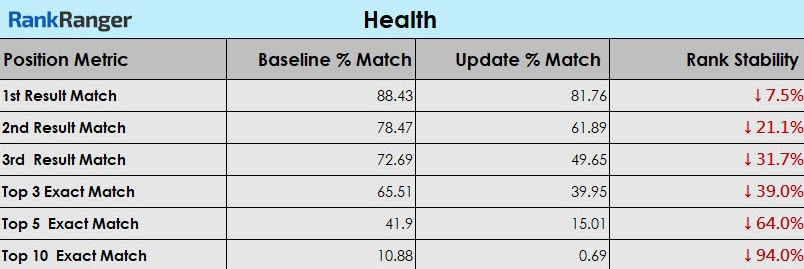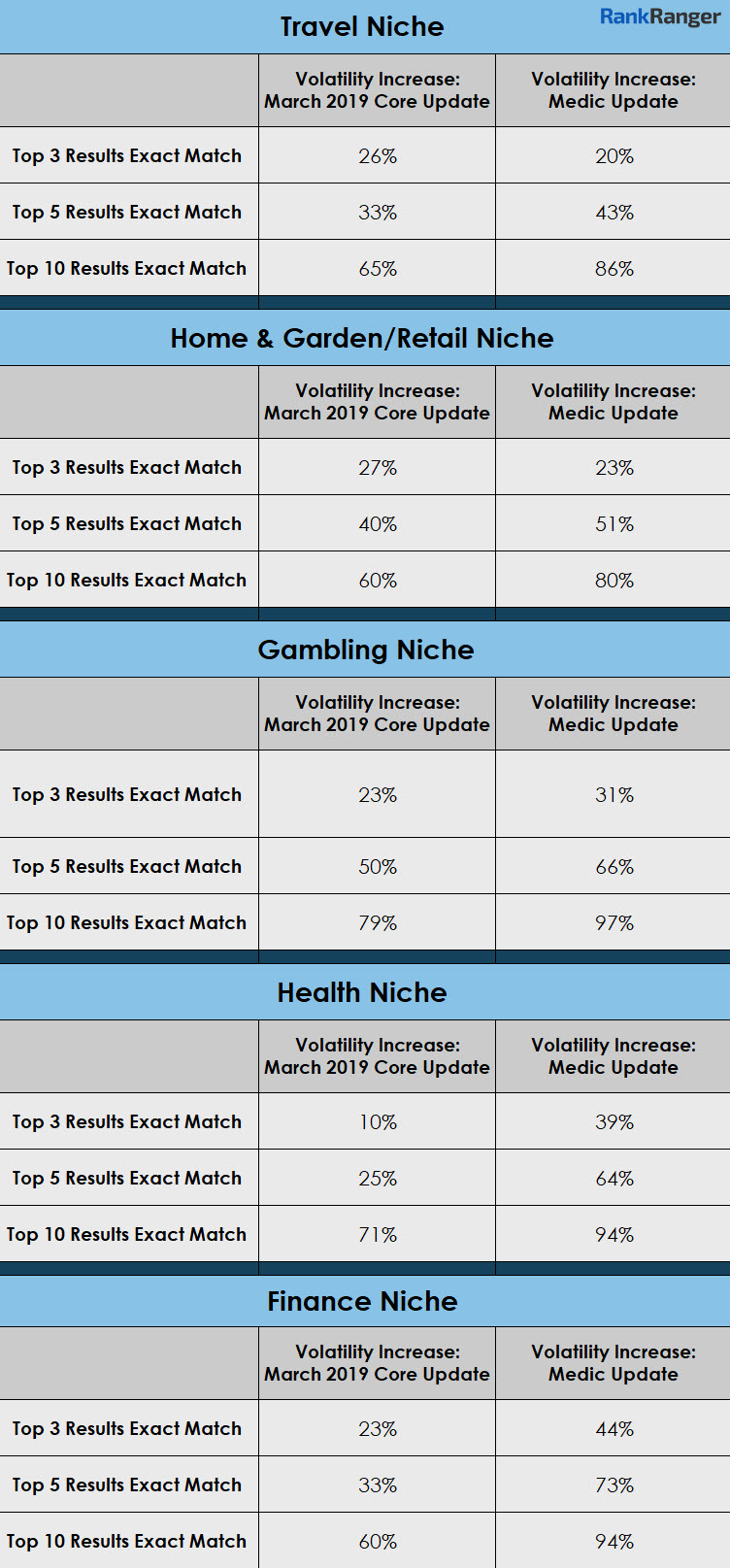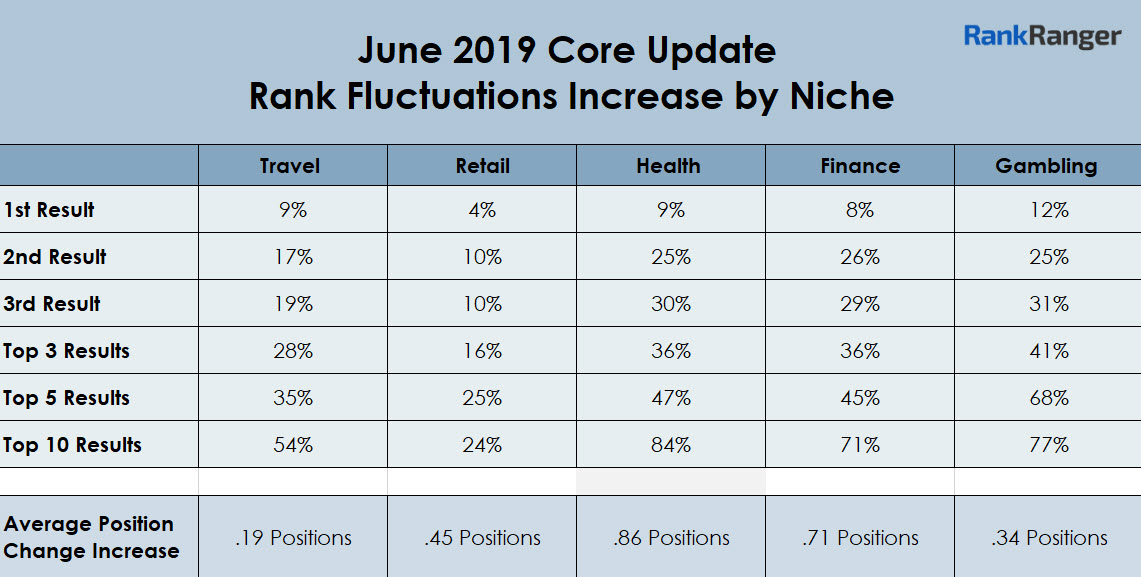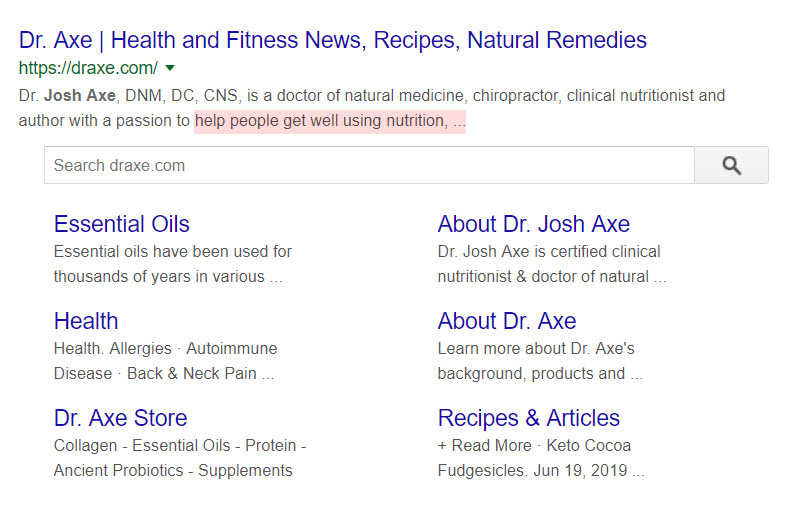Posted by
Mordy Oberstein
No matter how many times Google denies it, we keep coming back to the idea that the search engine’s broad core algorithm updates are targeting Your Money Your Life (YMYL) sites with a vengeance. It’s a conversation that just won’t die. With each new broad core algorithm update, we’re left to wonder… is Google targeting YMYL sites? Is it not targeting YMYL sites? And if Google isn’t targeting YMYL sites then why does it seem like it is?
And the reason for all of this is….
A Brief History of Google’s Core Updates & The Hoopla Over YMYL Sites
Google’s August 2018 Core Update was dubbed the “Medic Update” and for good reason. There was a clear and tangibly observable “focus” on YMYL sites. That is, sites within the Health and Finance verticals were quite obviously impacted to greater extents than sites belonging to other niche industries (data to come).
This was followed by the March 2019 Core Update, which saw some of the YMYL sites impacted by Medic undergo a bit of a reversal. (Note, that while some of the sites impacted by the Medic Update did see a bit of improvement in their rankings, they were, as a rule, still at a net loss as the gains were not nearly as drastic as the initial losses.)
While the “YMYL chatter” was a bit muted during the March 2019 core update it began again with renewed fervor after the June 2019 Core Update. Here too, there seemed to be a bit of a larger focus on changing the rankings of YMYL sites (again, data to come). Thus, you’re here reading this post because it seems the connection between Google’s core updates and YMYL sites simply won’t die.
Of course, as a result of there being a YMYL theme pervading Google’s core updates, there has also been all sorts of speculation trying to explain it. Some have said that the core updates were built to hunt down and hit YMYL sites in need of whatever sort of improvements. Concurrently, some have said that these sites have not been impacted any more than any other site type.
Neither of these are true.
There has definitely been a YMYL focus within some of the broad core updates. Yet, Google is not specifically looking to kill the rankings of certain YMYL sites or to specifically impact that niche in general.
In other words, are the core updates designed to target YMYL sites? No, no, and no.
Is it merely a coincidence then that there is a pattern showing a connection between the core updates and YMYL sites? No. That’s an absurd proposition. The algorithm is insanely intelligent. A focus on one type of site or one type of site being impacted more than others has to have an explanation. How could you suppose that the impact of core updates on YMYL is accidental when it keeps happening?
What I would like to do is walk you through some of the data from a few of the core updates, do a bit of qualitative analysis, and then show you what’s really going on with Google’s algorithm and YMYL sites.
What the Data Says About YMYL Sites and Google’s Core Algorithm Updates
While there is a glaring connection between Google’s core updates and YMYL sites it behooves me to establish this with some actual data. The industry’s assertions aside, there is some considerable data pointing to a relationship between the core updates and the sites that make up the Health and Finance niches.
The Medic Update and the Heavy Impact on YMYL Sites
Let’s start where this all began… the Medic Update. There is good reason that the update was dubbed the Medic Update and not the ‘August 2019 Core Update’. Here’s a look at the rank volatility increases per position on the SERP as well as ranges of positions on the SERP for the ******** niche during the Medic Update:

Here’s how the niche with the highest concentration of low quality/spammy sites (i.e., the ******** industry) compares to the Health niche:

It’s not even close. The first position on the SERP was stable within the ******** niche. We even recorded a slight increase in stability (though it’s nominal and most likely reflects a lack of increased rank fluctuations than an increase in rank stability). Compare that to the first ranking position within the Health niche which saw a whopping 7.5% increase in rank fluctuations. The same pattern manifests itself at both the 2nd and 3rd ranking positions with the Health niche being far more volatile than the ******** niche before we see a synchronization among the top 5 and top 10 results overall.
I could go on and show you the same pattern across any other non-YMYL niche. The point, however, is clear, YMYL sites were subject to greater rank instability than the other niche industries.
The YMYL Conversation Cools Off with the March 2019 Core Update
As I mentioned earlier, the March 2019 Core Update gave us a bit of a reprieve from YMYL conjecture. From an industry comparison perspective, the YMYL niches were not any more volatile than the other niches. In fact, in some cases, the YMYL niches were a bit more stable than the other industries:

More than that, there was a downturn in the level of volatility overall when comparing the March update to Medic. This applied across the board, even to the Health and Finance niches.
Still, and as indicated above, there was a trend that had some of the sites heavily impacted by Medic undergo a slight reversal. However, this pattern was not entirely pervasive. Also, as a general rule, these sites did not regain their total ranking losses. Meaning, the March 2019 Core Update was not a true ‘reversal’ by any metric.
The June 2019 Core Update Puts YMYL Back on the Table
The last stop on this train brings us to the June 2019 Core Update which very much put the notion of core updates being synonymous with YMYL back on the table.
A per niche look at the impact of the update says it all:

Leaving the ******** niche aside, for the time being, there is a clear split between the Health and Finance niches and the Travel and Retail niches. Across every metric, whether it be the 1st result on the SERP or the top 10 results overall, there were significantly higher levels of rank fluctuations that pervaded the YMYL niches.
However, that’s only half the story. If we look back at the last two updates, the March and June 2019 Core Updates, and the sites that were originally impacted during Medic, quite the telling pattern starts to emerge.
Many of the health sites that had at least some of their rankings restored during the March 2019 Core Update saw those rankings disappear into an ethereal blackhole as a consequence of the June 2019 Core Update. Google giveth… and Google taketh.
In other words… you had this:
Draxe.com

BodyBuilding.com

MedicineHealth.com

At the same time, there was an alternate version of this pattern. There were indeed health sites impacted during the Medic Update that got a ranking boost during the March update. This boost was then followed by a downshift that was reversed during the June update. As opposed to the sites shown above, these sites saw their higher rankings return per the June update:

No matter the particular pattern, the important thing to note is that there is a pattern. It’s hard to say there is no connection between the core updates and YMYL sites when aside from the niche data I presented there are unique rankings patterns that are pervasive at the site level.
In plain English, with vivid rankings patterns that apply across multiple updates…. how could there not be a connection between the core updates and YMYL sites?! That would be one mighty big coincidence.
The DNA of Google’s Core Updates & Its Deep Imprint on YMYL Sites!

Here’s where many jump the gun. Yes, there is a connection between the core updates and YMYL sites. That doesn’t mean, however, that Google has designed its algorithm updates to go after YMYL sites. Nor does it mean that there is any intention on the part of the search engine to impact YMYL sites to a greater extent than any other site within any other vertical. We’ve somehow jumped from there being a connection between the two that needs to be qualified to assuming that Google is hunting YMYL sites.
What then is the connection between the core updates and YMYL sites such that YMYL sites have been impacted to greater extents and such that it appears that Google is targeting YMYL sites with these updates?
Applicability.
It’s not that Google is designing its core updates to target YMYL sites. In fact, I would venture to say it’s entirely possible that when constructing its algorithm updates Google is not thinking about YMYL sites at all (well, maybe not at all).
So what keeps drawing us back to YMYL sites?
Applicability.
Applicability of the changes Google is making to YMYL sites.
The alterations to the algorithm that comes with the core updates are far more applicable to YMYL sites. And with greater applicability comes a greater emphasis, a greater degree of “algorithmic focus.” But it’s purely accidental, a by-product of what Google is now doing with its algorithm.
So what is Google doing with its algorithm now?
Site Profiling & Why It Means YMYL Sites Fall Into the Algorithm’s Crosshairs
If we’re going to understand how Google’s series of broad core updates are highly applicable to YMYL sites then we need to first understand what the updates are doing… obviously.
[A bit of a caveat before I get started with this: There are many aspects to a Google update. What I am about to show you is but one of them. So if you think there are other aspects to the update, know that so do I. You may now return to your regularly scheduled blog post.]
Google, with its core updates, is profiling your site.
The notion sounds kind of crazy until you start thinking. What has Google been doing, more than anything else, over let’s say the past two years? Trying to understand The Web qualitatively. Whether it be user intent, search journeys, or the Knowledge Graph… we’ve seen Google almost obsess over understanding things more intrinsically.
Now, we normally reserve Google’s qualitative analysis to things like user intent or entities… and I’m not sure why. Yes, I understand that seeing how Google better understands an entity is visible. We can see the actual changes in the Knowledge Panel. We can see how all of the SERP features Google shows when an entity appears on the SERP helps build a deep topical understanding of that entity. That said, conceptually speaking a site or a celebrity, vis-a-vis a qualitative/intrinsic understanding, is pretty much the same thing. So if Google uses machine learning to understand who Marlon Brando is… it also uses it to understand “who” your site is.
What I mean by Google understanding “who your site is” is that Google is aware of your site’s core intent profile. It knows what your site was created to do and if it’s actually doing that. So if your site is meant to tell you which of the latest Netflix releases is worth destroying your social, familial, and work-life over… it better do that (and not try to get you to buy a VPN so that you can kill even more brain cells by watching Netflix in 70 languages).
Google Profiling Your Site: Putting My Money Where My Mouth Is
Let me show you how this site profiling “thingy” has played itself out over the past few updates. One of the things that really caught my eye with the Medic Update was the number of health sites that tried to sell a health product amidst their content that subsequently got slammed by the update.
In other words, you had sites that portrayed themselves to be health information sites but had a strong e-commerce presence on all of their pages.
Here’s what the top of a recipe from the health site draxe.com looked like back in August of 2018:

Now here’s the bottom part of the same page:

That is a lot of product peddling for one page. So much so that it begs the question…. Is the purpose of this page to offer you a healthy recipe or to push its powders and classes and whatnot on you? I mean that in all seriousness, which would you say it is? If you knew nothing about this site, if you were looking at it with fresh eyes, wouldn’t that be a very hard question to answer?
It’s a hard question for us to answer and it’s a hard question for Google to answer. Google is aware of both profiles, both the informational content as well as the heavy e-commerce elements and they cancel each other out. More than that, the commerce profile seems to be latent (that’s my nice way of saying sketchy in that they hope you don’t notice what they’re really trying to do). To that, the site self-describes itself as a site to “help people get well using nutrition”:

Does this site, based on what you saw, do that? It’s a hard case to make since it seems it’s aim is to sell all sorts of products. Google seems to have thought so as well and destroyed this site’s rankings back in August of 2018.
By the way, if you head back to the same page now, not much has changed. And other than a two month period, not much has changed for this site’s rankings since the Medic Update either.
This is site profiling. This is the power of site profiling.
How Good Is Google at Profiling Sites
Before we get into how all of this ‘site profiling stuff’ actually translates into YMYL sites getting hit harder by Google’s core updates, let’s first understand how good of a site profiling game Google plays.
When analyzing the June 2019 Core Update there was one stat that stood out to me like none other: The Average Position Change.
When you think of a Google Update you think of wild ranking changes. That did happen during the June update, no doubt about it. However, the average number of positions a site moved as a result of the update across all niches was not what you would think. In fact, most sites moved maybe a position or so. Not 20 ranking positions, not even 10, or even 5.
What we’ve seen is that Google is getting far better at knowing what keywords fit into your site’s profile and what keywords don’t. And as opposed to starting at the beginning of the learning curve, which would demand large ranking corrections, Google is very nuanced in its understanding of what does and what does not fit into your site’s profile.
Think of it like this: The smaller the changes Google makes, the smaller the ranking adjustments during an update, the better and more nuanced the understanding of your site.
And Google has gotten far more nuanced. Back in August of 2018, sites were moving between 3-4 ranking positions on average depending on the niche! Almost a year later it’s easy to see that Google has gotten better at profiling sites and is making highly nuanced rank adjustments as a result.
Why YMYL Sites Seem to Be the Target of Google’s Core Algorithm Updates

Now for the fun part. Remember when I said YMYL sites are more applicable to the changes Google is seeking to execute via the core updates? Here’s how it all plays itself out….
Not all poor or conflicting site profiles are equal. Take ESPN, the world’s leading sports news website, for example. It’s pretty easy to imagine the profile Google ascribes to the site… it’s a sports news site. However, imagine that in every article, on every page on ESPN’s site are all sorts of pop-ups, CTAs, links, and banners for a sports streaming subscription. What would the site’s profile look like then? It’s again pretty easy to imagine Google saying, “Well ESPN, you say you’re a sports information site, but it really seems like you want to sell people a streaming service so that folks can watch sports.”
In such a scenario the authority of ESPN’s content would be called into question. In other words, Google would have to ask, “To what extent can we trust this content if its focus isn’t really sports information? If the site is really focused on getting subscribers, how authoritative is the content when the site portrays itself as an informational site?”
By the way, you can see how Expertise, Authoritativeness, and Trust (E-A-T) would enter the conversation right there (E-A-T is a major part of the YMYL/core update conversation). A site’s profile and a site’s authoritativeness and so forth are directly connected, they’re the flip side of each other. (I’ll get back to this later on.)
What Site Profiling Brings Is Far, Far, Far More Relevant to YMYL Sites
So ESPN (in our example) has an authority problem but what’s the impact of that on users? I literally mean what would happen to users if ESPN’s content really weren’t authoritative, if it weren’t truly reliable?
What, you would get the wrong sports score? Assimilate some pretty bad analysis on what your favorite team should be doing in the offseason?
OK, not a good thing… but is anyone going to die over it? No.
Now ask the same question for a health site whose content authority is called into in question…. Is anyone going to die over it? Maybe, yeah!
In other words, finding a problem with a site’s profile calls its authority into question. Finding a problem with a YMYL site’s profile calls its safety into question!
Now you tell me, should a sports news site with a profile problem lose rankings to the same extent as a YMYL site with a profile problem?….. I didn’t think so either.
And now you understand why YMYL sites keep getting impacted by the core updates more than other niches! The overall change Google is trying to make in that it wants a site to rank well for what is part of its core identity also means that a YMYL site is more applicable to seeing ranking losses when that profile has issues.
What it means for a non-YMYL site to have a poor or conflicting profile is not what it means for a YMYL site to have the same. In one instance there is no concern over user safety (as a rule). With non-YMYL sites, there is usually no major risk knocking at the door. As a result, the core updates are far more applicable to YMYL sites.
Bringing the Core Updates Impact on YMYL Sites Full Circle

Everyone knows the best part of a cake is the icing, and the icing on this cake is just as good. On the one hand, it seems like Google is specifically targeting YMYL sites with its core algorithm updates. Yet, on the other hand, we have Google saying that they do no such thing. Wouldn’t you know it, our approach here perfectly explains how both positions/perceptions can be true!
There is nothing in the algorithm that specifically relates to YMYL sites any differently than other sites on the web. There is nothing built into the core updates that directly deals with YMYL sites in a special way. So when Google says that the core updates are not designed to treat YMYL sites with any variance… that is true.
Yet, you could see why it would be easy to perceive the updates to be targeting YMYL sites. The nature of the core updates is more impactful when dealing with YMYL sites. The natural result of the updates when dealing with YMYL sites inherently means a greater impact vs other niches.
The idea of the nature of the core updates being more applicable to YMYL sites perfectly explains how it is possible that there is nothing special built into the core updates that targets YMYL sites while the niche is affected by the updates more than any other niche across multiple updates.
And there you have it… it all fits! Glad that’s settled!

